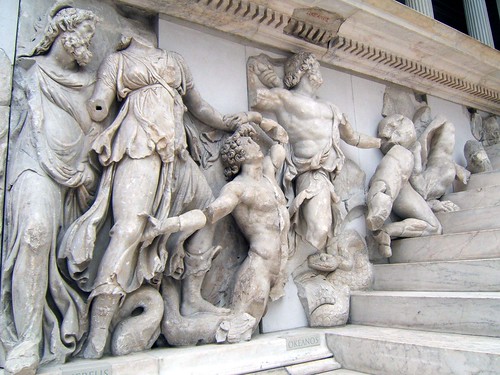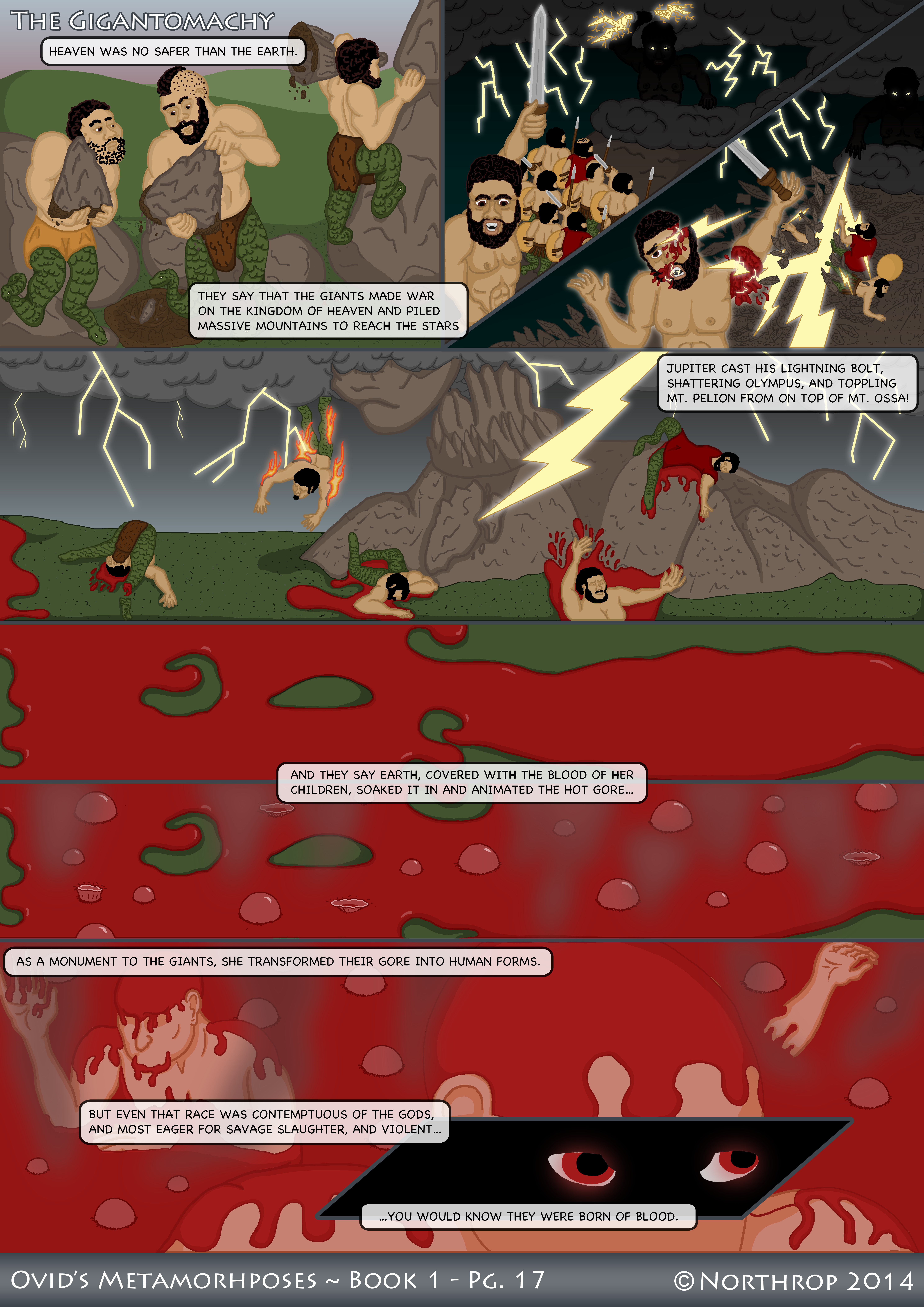Met. 1.151-62 – The Gigantomachy
NEVE FORET TERRIS SECURIOR ARDUUS AETHER,
ADFECTASSE FERUNT REGNUM CAELESTE GIGANTAS
ALTAQUE CONGESTOS STRUXISSE AD SIDERA MONTES.
TUM PATER OMNIPOTENS MISSO PERFREGIT OLYMPUM
FULMINE ET EXCUSSIT SUBIECTAE PELIO OSSAE.
OBRUTA MOLE SUA CUM CORPORA DIRA IACERENT,
PERFUSAM MULTO NATORUM SANGUINE TERRAM
IMMADUISSE FERUNT CALIDUMQUE ANIMASSE CRUORUM
ET, NE NULLA SUAE STIRPIS MONIMENTA MANERENT,
IN FACIEM VERTISSE HOMINUM. SED ET ILLA PROPAGO
CONTEMPTRIX SUPERUM SAEVAEQUE AVIDISSIMA CAEDIS
ET VIOLENTA FUIT; SCIRES A SANGUINE NATOS.
NOR WOULD THE BURNING AETHER BE ANY SAFER THAN THE EARTH:
THEY SAY THAT THE GIANTS MADE AN ATTEMPT ON THE KINGDOM OF HEAVEN,
AND PILED MASSIVE MOUNTAINS UP TO THE HIGH STARS.
THEN THE OMNIPOTENT FATHER SHATTERED OLYMPUS
WITH HIS LIGHTNING BOLT, AND KNOCKED PELION OFF OF OSSA.
THEIR HORRID BODIES LAY WITH THE MASS COVERING THEM,
AND THEY SAY EARTH, SPLASHED WITH THE COPIOUS BLOOD OF HER CHILDREN,
SOAKED IT IN AND ANIMATED THE HOT GORE.
AND, LEST NO MONUMENT REMAIN FOR THEIR RACE,
SHE TRANSFORMED IT INTO HUMAN FORMS. BUT EVEN THAT RACE
WAS CONTEMPTUOUS OF THE GODS, AND MOST EAGER FOR SAVAGE SLAUGHTER,
AND VIOLENT; YOU WOULD KNOW THEY WERE BORN OF BLOOD.
I mentioned this comic was gonna get NSFW, right? Yeah, I totally did; if you missed that, check out my disclaimer for the details. This is what happens when I illustrate while watching The Walking Dead (love that show). Well, it’s that, and also what happens when Ovid gives me a passage that is just blood-blood-blood over and over again. This page represents the Gigantomachy, or war between the gods and Giants, who were snake-footed children of the Earth). It’s an old and famous story that Ovid pretty much just summarises. Despite the condensed nature of this version, between the Iron Age and the Gigantomachy, Ovid uses words for ‘blood’, ‘gore’, ‘guts’ and ‘slaughter’ a total of seven times, with the words increasing in frequency as the passage goes on. However, despite human evil and war-mongering, most of the gorey violence is actually directed at the Giants. This is, of course, an ironic (or perhaps appropriate?) twist; the avatars of violence are themselves the principal victims of it. When I called them “avatars”, I really do mean that they are the culminating representation of the evil trend in the Iron Age. As children of the Earth, they are grotesque and chimeric, having snake feet; their deformity represents their dual nature as both humanoid, and yet inhuman. In context here, they represent the epitomy of the violent nature of the Iron Age, a crude caricature of its abysmal sin. They take it, however, one step further, and launch an assault on the gods. They fail miserably: Ovid omits any of the traditional struggle between the two sides, opting instead for the battle to be concluded by a single lightning bolt from Jupiter. It is the first of a series of act of overkill by the Olympians in dealing with humanity. The evils of mortals are certainly evident in the Metamorphoses, but the gods are not so clean either. The Giants may have deserved their fate (although the reference to their mother, at line 157, does lend them some sympathetic light), as will the men born of their blood (Schmidt (1991: 32) calls them Gigantenblutmenschen, which is my new favourite German word); nevertheless, the gods will eventually go (what some might consider) too far. We see here only a taste of the potential for their abuse of power.

Detail from the Altar of Pergamon
The Gigantomachy is an old, old story, with many versions and variations. It goes all the way back to Homer, who mentions the stacking of the mountains at Odyssey 11.305-20. As you may have already guessed, Hesiod also, in his Theogony (lines 807-68), describes the gods’ war with Typhoeus, a giant-like figure who battles Zeus on Olympus. The war is also a popular one in art, and famously decorates the great altar at Pergamon (check the photos). From the images at Pergamon, you can see that earlier versions were more of battle, and less of an outright slaughter. On a metaphorical level, it is tempting to view the Gigantomachy as an allegory for the struggle between chthonic (earth-based), and celestial (sky-based) religion, which was (and continues to be in the form of Christianity) the dominant religious expression in the Western World. The Giants are, after all, the children of the Earth, and they fight against the gods of the sky, in their attempts to control heaven. It is completely insubstantiable, but helps to illustrate the possible ideas at play in the myths of the early cosmos. At any rate, this would be a distant concern to Ovid, whose main purpose in his own Gigantomachy was to illustrate the growing conflict between heaven and earth, which will be a recurring theme throughout the Metamorphoses. Ovid’s positioning of the Gigantomachy is actually a bit of a poetic coup; the story was famously the most played-out one in Greco-Roman literature. We have no surviving examples of epics dedicated to it, but we do have Ovid at Amores 2.1 claiming to have written one. This is, in all probability, a joke of the kind Ovid was fond of making about a supposed epic career for himself. The Amores was in fact his first collection of poetry,

and he jokes in the very first poem that Cupid would not let him write an epic. It seemed like a ridiculous notion when he wrote his first book of poems, but he holds himself with dignified grace here in his actual epic project. Ingo Gildenhard and Andrew Zissos, in their article “Inspirational Fictions” (2000), show how Ovid self-assuredly ties the epic Metamorphoses back to his early works. In the proem, he tells how the gods changed his project (line 2), and later he will negotiate a new, epic role for the previously anti-epic Cupid. In these lines here, he finally visits the topic of the Gigantomachy. When he does, however, he ties it neatly into a sequence of war between heaven and earth. It’s position absorbs it into a larger narrative, rather than let it stand alone. Thus, by placing it in context of the ages (and the events to follow), Ovid can have his cake and eat it too; he tells the story he shouldn’t be telling, but makes it work in new context. In this way, he gives new poetic life to a played-out tale.

Discussion ¬